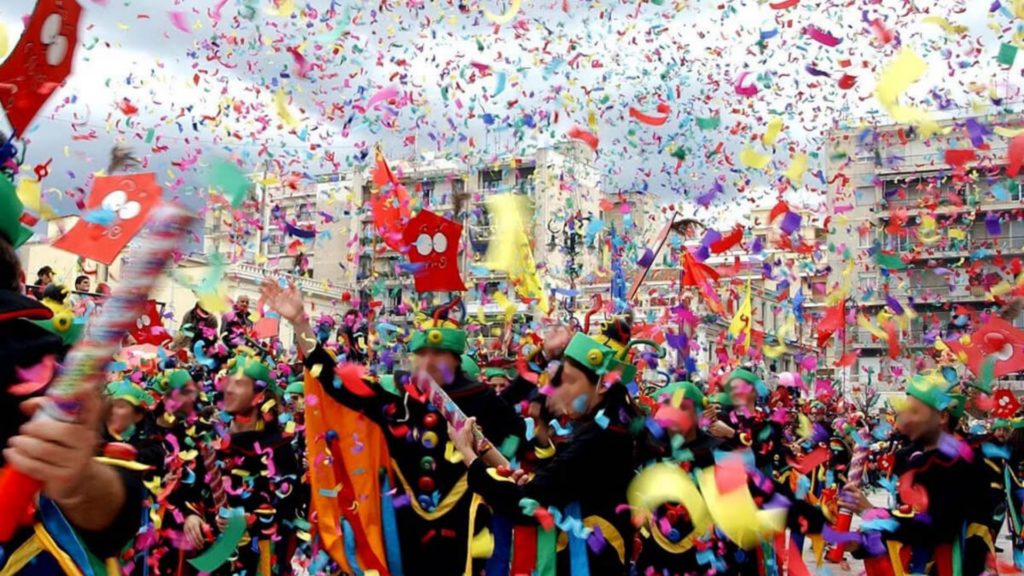Apokries (Carnival) time in Greece is filled with spectacular traditions, masquerading and all manner of performances. From local fertility-rites to other events with pagan roots, festivities are held in the weeks before Lent with the biggest events taking place on the last weekend before Clean Monday that falls on March 11 this year.
We asked three Neos Kosmos reporters to convey the merriment and fun of the carnival time in destinations around Greece.
Having grown up with old black and white Greek films, like “Marriage Greek Style”, where Xenia Kalogeropoulou and Yiorgos Konstantinou met and fell in love while masquerading on the crowded streets of Plaka, I had high expectations of what carnival time would be like in Athens. But alas, even in the Nineties, the city’s oldest quarter – Plaka – had lost much its neighbourhood feel and carnival spirit, though I did have the experience of getting clobbered on the head with a plastic club held by gaudy masqueraders coming out of a taverna. Most of the masquerading in the area these days happens at scheduled events at the folk art, music and children’s museums that revive and educate people of apokries customs from around Greece. The Athens Municipality does all it can to bring to life the customs, but it is mainly fodder for kids around Zappeion and the National Gardens.
My fondest memories of apokries came to life when I became a mother myself and managed to live a childhood filled with carnival capers I never got to enjoy as a girl growing up in Sydney. And that’s when I discovered Moschato, a working class family suburb in southwest Athens, that is nothing special all year round but is covered in confetti, glitz and fairyfloss come apokries. Yes, if I were a director these days, that’s where I’d get Xenia, dressed as a nun, to meet Yiorgos, dressed as a Roman soldier… – MS
XANTHI
Ask any local in Greece’s north for recommendations on celebrating apokries and they’ll tell you there’s no debate here; Xanthi is the place to go. Myself included I must admit. I’ve visited Xanthi a few times but my fondest memories come from carnival time. With its beginnings traced back to 1966, the festival is considered the second biggest one in the country and attracts thousands of visitors every year. Running for two weeks, it features dozens of local cultural associations presenting theatre plays, dance performances, exhibitions and many more throughout the whole day.
Remember, the heart of the celebrations is located out in the street. Try out a walking tour to learn about the city’s fascinating history and cultural past or just take an evening stroll by yourself in the old city quarter’s laneways and you’re bound to meet disguised groups of people spreading the Apokries fun. The city’s nightlife is vibrant regardless, but has a different feel during those 15 days, with outdoors concerts of popular artists and tavernas filled with people at all times. If you want to blend in with locals, join a live music party at a bar (Hint: Dili Dili is my personal favourite, perhaps because it’s the place where you’re most likely to see a band bold enough to mix traditional Thracian songs with punk, folk-jazz or… you name it!).
If you’re there on the final day you’ll watch the Great Carnival Parade (takes place in the afternoon) with floats of masked revellers, colours and music filling the streets. But the highlight of the festival is the night closing ceremony at the Kossynthos river bridge with the re-enactment of an Eastern Thrace custom, To kapsimo tou Tzarou (the burning of Tzaros) followed by a spectacular firework display. – ZT
There are quite a few fond memories I have – just like almost any other Greek person) from this time of year, that gives people an opportunity to dress up, go out and have fun. So many parties, so many people coming together. Out of all those times though, the one that stands out the most would be the trip my family and I took to the city of Patra. Every year at the time of the apokries, the city holds a huge festival, well-known to those from out of town and even visitors from other countries. There are many people and chariots parading out in the streets for days, with confetti and spray decorating the entire town. Of course the live shows and the music go on for days and the joyous atmosphere is infectious, as people join the celebrations whether they’re in costume or not. Even though I was just a little over 13 years old when I was first taken to the carnival, I still remember the many different and vibrant colours of the various outfits of the people dancing in the streets. And there were many people across different countries and cultures gathered in Patra, as I recall seeing one of my uncles interacting with tourists from Japan who were there just to take part in the festivities. Going to the festival of Patra is a unique occasion for those that live in Greece and a once in a lifetime event for tourists. It is literally a party that goes on for days.
* This year, organisers of the Patras carnival ensured the city got a spot in the Guinness World Records with the “largest carnival dance” on Thursday – the simple 8-minute number was executed by more than 1,000 professional and amateur dancers, along with city residents and visitors that joined the fun. – AA








